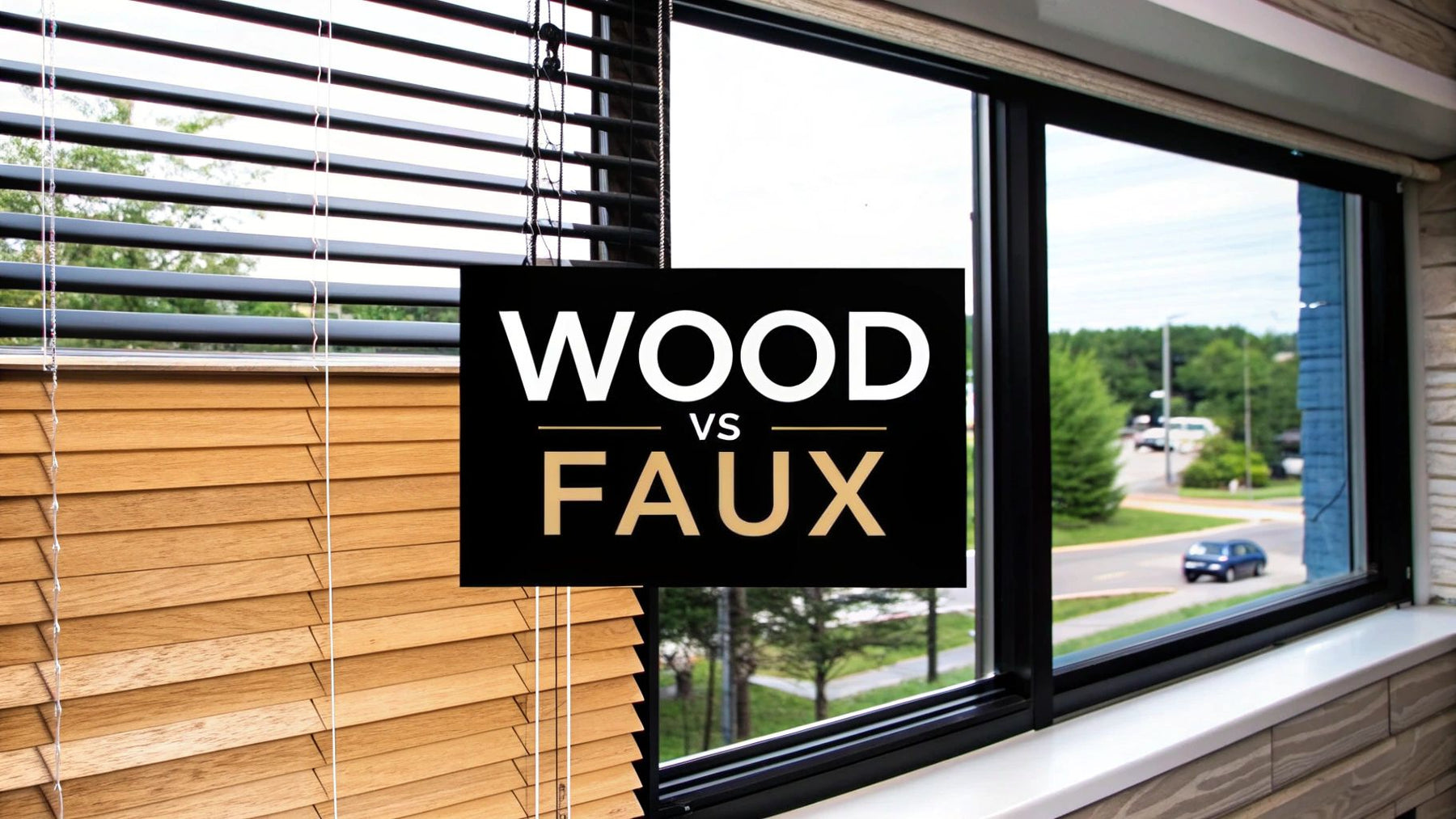
Wood Blinds or Faux Wood Blinds? The Definitive 2024 Guide
Deciding between real wood blinds or faux wood blinds often comes down to one key question: Are you prioritizing authentic, natural beauty or practical, everyday durability? It's the classic head-versus-heart choice for your windows, and the right answer depends on the room.
The short answer is this: Real wood offers an unmatched, lightweight elegance perfect for living rooms and bedrooms. Faux wood, however, is a resilient workhorse, boasting superior moisture resistance that makes it the undisputed champion for kitchens, bathrooms, and high-humidity climates.
This guide will walk you through the key differences in durability, style, cost, and maintenance to help you make a confident choice for your home.
Table of Contents
- Wood vs. Faux Wood: A Quick Comparison
- Material and Durability: What Are They Made Of?
- Style and Aesthetics: Which Looks Better?
- Cost and Value: Which is the Smarter Investment?
- Cleaning and Maintenance: A Tale of Two Routines
- Room-by-Room Guide: The Right Blinds for Every Space
- Frequently Asked Questions
Wood vs. Faux Wood: A Quick Comparison
When you're at this crossroads, a direct comparison is the best place to start. While both options provide the timeless, slatted look for light control and privacy, their core materials create a world of difference in performance, cost, and care.
Faux wood blinds are typically crafted from PVC or a composite material, which gives them a tough, nearly waterproof quality. This engineered approach is common in modern home goods; for a deeper dive, this guide to Thermofoil cabinets is a great resource on similar materials.
Real wood blinds, in contrast, are cut from 100% natural hardwoods like basswood. This gives them authentic grain patterns and a warmth that simply can't be perfectly replicated—a major reason they remain a popular choice in the window treatment market.
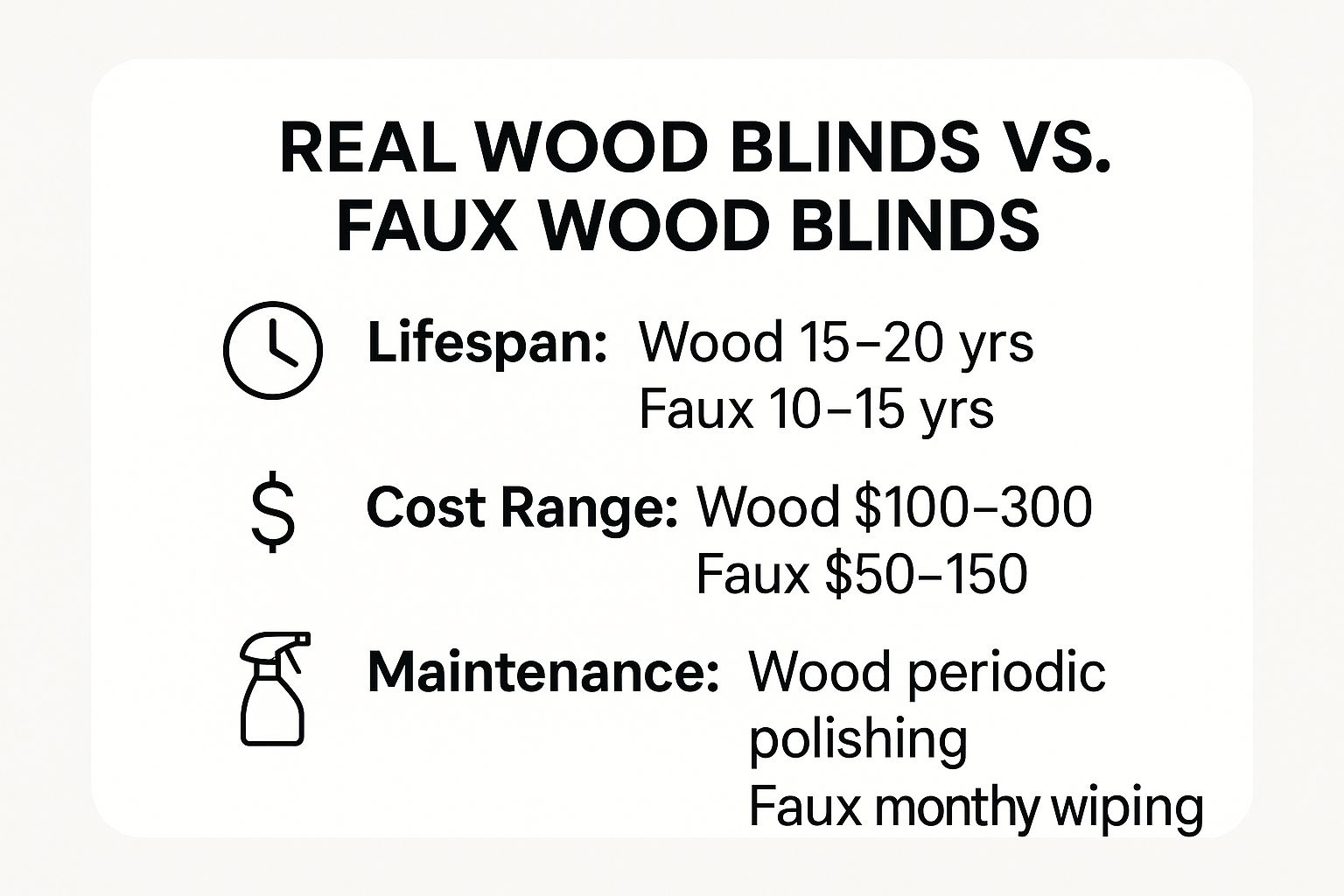
As you can see, real wood's higher price point often comes with a longer potential lifespan, but it also demands more specialized care. This balance of options has helped the global market for blinds and shades grow to a value of USD 14.82 billion, with blinds alone accounting for over 58% of that revenue.
Here’s a quick summary table to see the core differences at a glance.
Wood vs Faux Wood at a Glance
| Feature | Real Wood Blinds | Faux Wood Blinds |
|---|---|---|
| Material | 100% natural hardwood (e.g., basswood) | PVC, vinyl, or composite material core |
| Best For | Living rooms, bedrooms, and large windows | Bathrooms, kitchens, and high-humidity areas |
| Durability | Prone to warping/fading from moisture | Highly resistant to moisture, warping, and fading |
| Weight | Lightweight, easier to lift on large windows | Heavier, can be cumbersome for wide windows |
Now, let’s get into the specifics of what these differences mean for your home.
Comparing Material Composition and Durability
The choice between wood blinds or faux wood blinds really boils down to what they're made of. This directly affects their durability, longevity, and suitability for different rooms in your house.
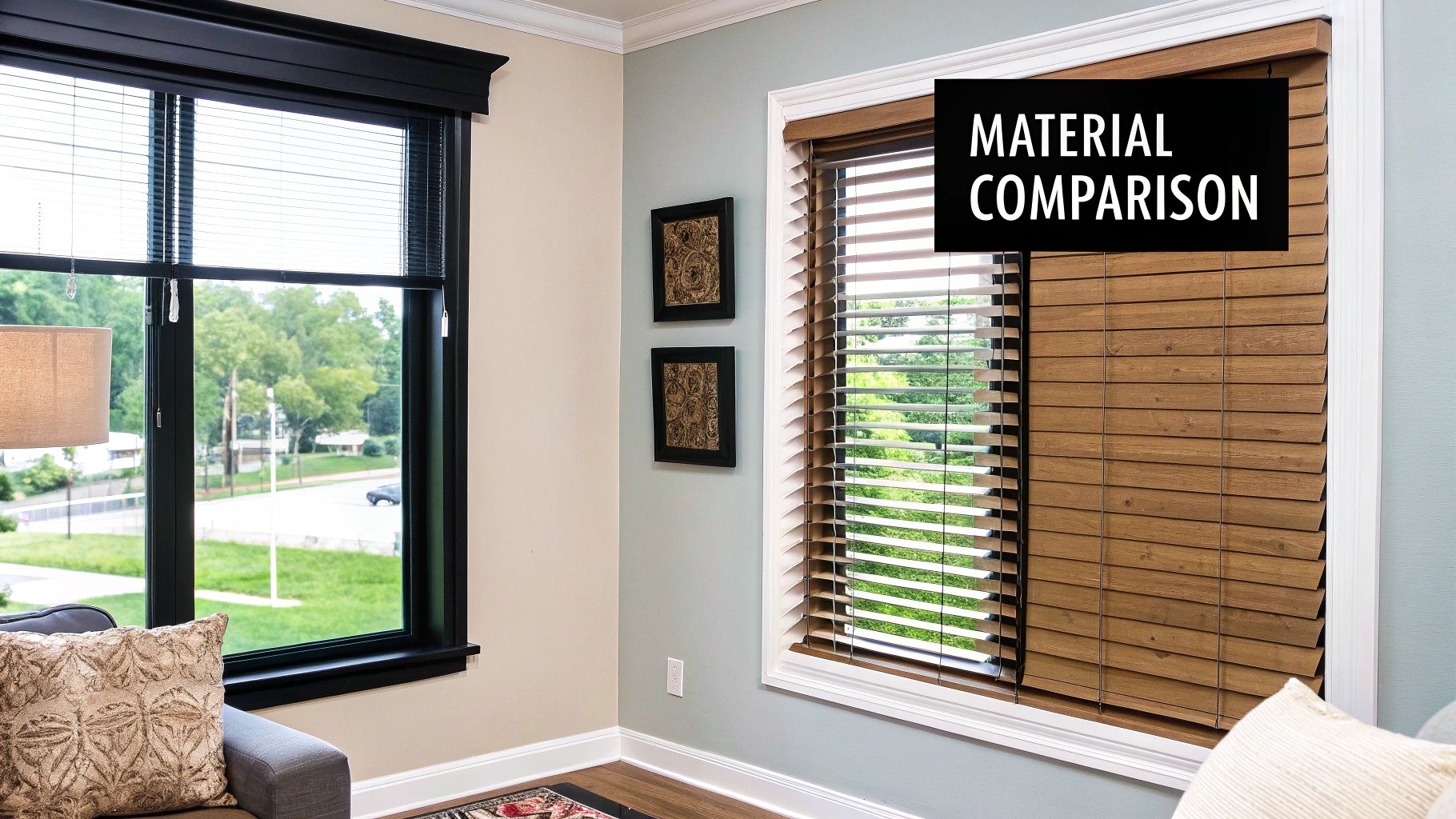
Real wood blinds are crafted from 100% natural hardwood—most often basswood or ramin wood. This provides an authentic, one-of-a-kind grain pattern and makes them noticeably lighter than their synthetic cousins.
But that beautiful, organic nature is also their biggest weakness. Just like any other natural wood product, they have a serious aversion to moisture.
Key Insight: Think of real wood as a sponge in humid conditions. Constant exposure to steam or high humidity will make the slats warp, swell, or even crack over time. That’s why they’re not the best idea for bathrooms and kitchens.
The Power of Faux Wood Construction
So, what are faux wood blinds made of? The short answer is a highly durable synthetic material. They are engineered with a core of polyvinyl chloride (PVC) or a composite wood material, which is then given a tough, finished coating. This synthetic makeup is what makes them practically indestructible in challenging spots.
This material is completely non-porous and waterproof. You could submerge a faux wood slat in water, and it would come out looking the same. This incredible moisture resistance makes them the only sensible choice for:
- Bathrooms: They handle daily shower steam without any risk of damage.
- Kitchens: Splashes from the sink or humidity from a boiling pot won't make them warp.
- Laundry Rooms: The constant high moisture levels in these areas are no threat.
- Humid Climates: If you live in a coastal or tropical area, faux wood is your worry-free solution.
Weight and Structural Considerations
While faux wood is the clear winner on moisture resistance, its density comes with a trade-off: weight. Faux wood blinds are much heavier than real wood blinds. For a standard window, you might not notice the difference.
But on extra-wide windows, that added weight is a real factor. It can strain the mounting hardware and make lifting the blind a chore. This is where the lightweight nature of real wood becomes a huge practical advantage, giving you much smoother operation. Choosing the right material is a key part of an environmentally-friendly interior design strategy that values both longevity and suitability.
Evaluating Style, Aesthetics, and Customization
When you're weighing wood blinds or faux wood blinds, the look is often the deciding factor. This choice sets the tone for your room, shaping the light and the overall design story.
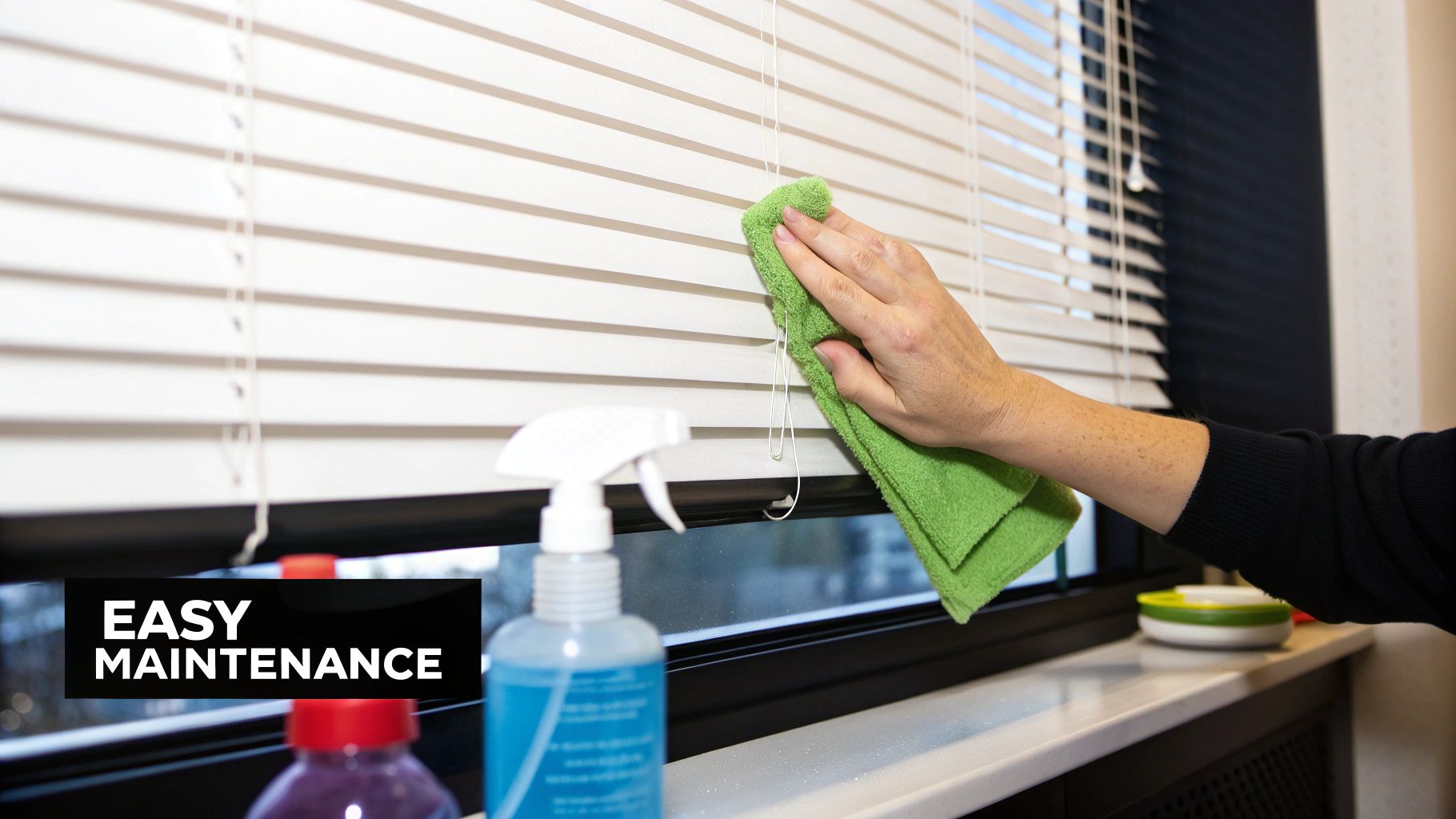
There’s an authentic, organic feel to real wood blinds that’s impossible to fully replicate. Each slat features a unique grain pattern, a subtle nod to its natural roots. This variation brings depth and warmth to a space, giving it a premium touch.
The Appeal of Natural Wood Finishes
The magic of real wood is its ability to take a stain. This opens up a world of design possibilities, letting you perfectly match your blinds to other wood elements in your home, like:
- Hardwood flooring
- Kitchen cabinetry
- Wooden furniture
- Interior trim and molding
This creates a cohesive and polished look. For rooms where you want to dial up the warmth and elegance—a formal living room, a cozy study, or a peaceful bedroom—the rich texture of stained wood is second to none.
Key Stylistic Differentiator: The biggest advantage of real wood is how it takes a stain. The color is rich and transparent, letting the natural grain shine through. This creates a character that a simple painted finish can't match, making it the go-to for classic or rustic interiors.
The Clean Look of Faux Wood
Faux wood blinds are fantastic mimics, but they truly shine in their own aesthetic space. You’ll mostly find them in painted finishes, with crisp whites, off-whites, and cool grays leading the pack. This makes them a perfect match for modern, minimalist, or coastal designs.
Their consistent, uniform appearance gives a clean look across multiple windows, creating a bright, airy atmosphere. While some high-end faux wood blinds offer a stained look, they sometimes miss the nuanced depth you get with the real deal.
This divide between natural elegance and practical style is a major force in the window treatment industry, which has topped USD 26.1 billion in market size. You can discover more insights about the window coverings market and where it's headed.
Understanding Cost and Long-Term Value
Let’s talk money. When weighing wood blinds against faux wood blinds, the budget is always part of the conversation. But this isn't just about the upfront price—it’s about the true value you get over the long haul.
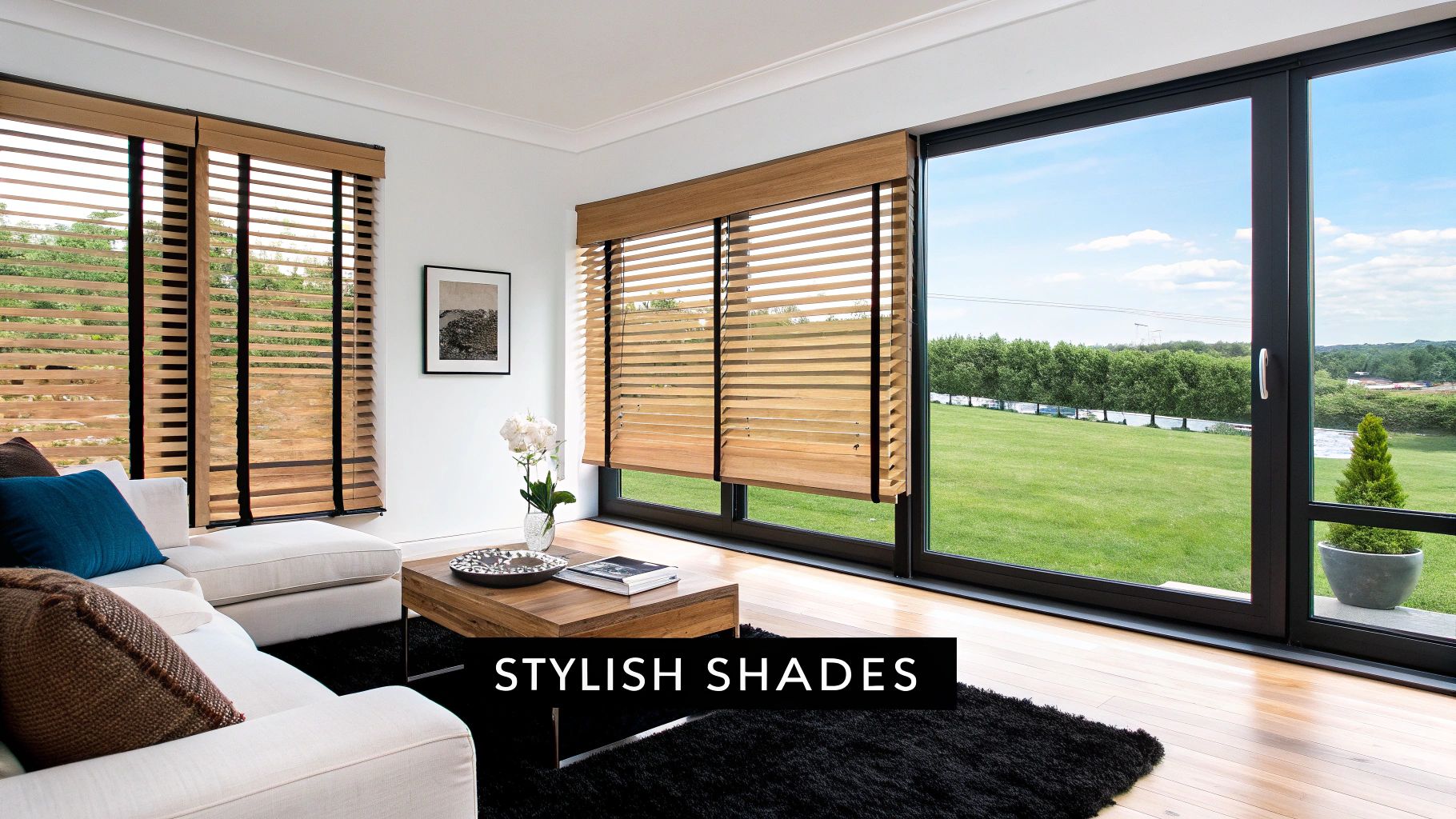
If we're looking only at the initial cost, faux wood blinds are almost always less expensive. Their PVC or composite materials are simply cheaper to produce than genuine hardwoods. This makes them a fantastic pick if you're on a tight budget or outfitting an entire home.
Real wood blinds carry a premium price for a reason. From sourcing high-quality basswood to the craftsmanship of finishing each slat, every step adds to the cost. The result is a lighter, more refined product that feels like a true upgrade.
Looking Beyond the Initial Price Tag
True value reveals itself over years of use. While faux wood is easier on the wallet initially, its real strength is performance in tough spots. In a steamy bathroom or a sunny kitchen, you won't have to worry about replacing them due to warping or damage. Our moisture-resistant faux wood collection was created for exactly that kind of worry-free durability.
On the flip side, real wood blinds are a long-term investment in your home’s character and even its resale value. Much like hardwood floors, they are often seen as a luxury feature that can boost a home’s appeal to prospective buyers.
Investment Insight: While faux wood is the practical choice for durability, real wood can add tangible resale value. It elevates a room's perceived quality, making it a smart upgrade for high-impact spaces like living rooms and primary bedrooms.
The global window blinds market is projected to hit around USD 6.15 billion by 2033, fueled by new construction and a focus on energy efficiency. This shows homeowners are thinking more deeply about costs and benefits. You can read the full window blinds market analysis to dive into these trends.
If you need a durable, budget-friendly solution for a humid area, faux wood offers incredible value. But if you’re looking to add timeless elegance that could increase your home's equity, the investment in our premium real wood blinds might just pay for itself.
How to Clean and Maintain Your Blinds
The long-term beauty of your blinds comes down to proper care. When weighing wood blinds or faux wood blinds, it’s worth knowing their maintenance routines are very different. The right choice may depend on how much time you’re willing to spend cleaning.
Real wood blinds are stunning but sensitive. Moisture is their biggest enemy, so water or harsh chemical cleaners are off-limits. Using them can cause permanent warping, discoloration, or ruin the finish.
Faux wood blinds, however, are the definition of low-maintenance. Their waterproof construction means you can wipe them down without a second thought, making them perfect for busy households.
Cleaning Your Real Wood Blinds: Step-by-Step
For real wood, your mantra should be dry and gentle. Regular dusting is your best defense.
- Gather Supplies: You'll need a soft cloth, feather duster, or a vacuum with a soft brush attachment.
- Dust Regularly: Once a week, gently wipe each slat from the center outwards.
- Spot Clean: For stubborn spots, slightly dampen a cloth with a wood-safe cleaner or furniture polish. Apply it sparingly and wipe the slat dry immediately.
Expert Tip: Never spray cleaner directly onto your wood blinds. Always apply it to your cloth first. This gives you total control over moisture and prevents saturation, a simple step that can add years to their life.
Maintaining Faux Wood Blinds
Faux wood blinds are much more forgiving, making care incredibly simple. Their non-porous surface is highly resistant to moisture and stains. For a detailed walkthrough, check our guide on how to clean Venetian blinds, as many principles apply.
For a quick clean, a damp cloth is all you need. For tougher grime like kitchen grease, a bit of mild soap and water will do the trick. Just wipe them down and let them air dry—they are built to handle it.
Choosing The Right Blinds For Each Room
Picking the perfect blind isn't just about material—it's about where it's going to live. The debate between wood blinds or faux wood blinds often boils down to the demands of each room. This guide will help you find the ideal fit for every window.
When dealing with high-humidity areas, the choice is simple. Faux wood blinds are the clear winner every time.
High-Humidity Heroes: Faux Wood Blinds
Some rooms are defined by moisture and steam. In these spots, real wood is a recipe for disaster; it's practically guaranteed to warp or crack. Faux wood, on the other hand, was built for these conditions.
- Bathrooms: Constant shower steam won't faze waterproof PVC slats. When considering room-specific needs, finding the best blinds for bathrooms is a great place to start.
- Kitchens: Splashes and steam are no match for faux wood's durability.
- Laundry Rooms: The high humidity makes faux wood the only sensible, resilient choice.
Situational Recommendation: If a room has a sink, shower, or gets steamy, just go with faux wood. Its moisture-proof design guarantees zero maintenance headaches down the road.
Elegance in Living Spaces: Real Wood Blinds
For rooms where style is everything, real wood blinds bring unmatched warmth and elegance. The natural grain and lighter feel are perfect for crafting a cozy, inviting atmosphere in your main living areas.
In a bedroom, for example, the rich texture of real wood helps create a serene, upscale vibe. To learn more, check out our guide on the best blinds for bedrooms.
However, consider direct sunlight. Over years, intense UV rays can cause the finish on real wood to fade. If a window gets blasted with harsh sun all day, a high-quality, UV-resistant faux wood blind might be the more practical move.
Finally, for extra-wide windows in a living room, the lighter weight of real wood is a huge plus. It makes lifting and lowering them smooth and effortless.
Frequently Asked Questions
When deciding between wood and faux wood blinds, a few key questions always come up. Here are the straight answers to help you choose with confidence.
Are faux wood blinds heavier than real wood blinds?
Yes, significantly. Faux wood blinds are made from a dense composite PVC material, making them much heavier than natural hardwood blinds of the same size. For very wide windows, the lighter weight of real wood makes them easier to lift and operate daily.
Do faux wood blinds look cheap?
Not at all, especially with today's high-quality options. Modern manufacturing creates embossed grain patterns that convincingly mimic the texture of real wood. While they lack the unique character of natural wood grain, premium faux wood blinds offer a clean, polished, and sophisticated look that many people can't distinguish from the real thing from a few feet away.
Can I use real wood blinds in a kitchen?
It's generally not recommended, especially near a sink or stove. Real wood is porous, and the combination of steam, heat, and potential grease splatters can cause the slats to warp, crack, or stain. Faux wood blinds are the superior choice for kitchens due to their moisture resistance and ease of cleaning.
Which blinds provide better insulation?
Both options offer decent insulation, but real wood has a slight edge. The natural cellular structure of wood is inherently better at trapping air, which helps block the sun's heat in the summer and keep your home warmer in the winter. While the difference isn't massive, real wood holds a small advantage for energy efficiency.
Ready to find the perfect blinds for your home? At Joey'z Shopping, we offer a curated selection of both real wood and faux wood blinds to fit any style and budget. Explore our complete collection today.
